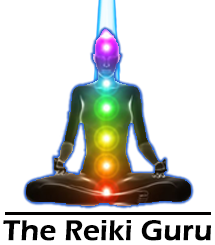Chakras and Aura teaching is not part of Dr. Mikao Usui’s or Dr. Chujiro Hayashi’s original Reiki teaching. After the passing of Mrs. Takata in 1980, it became a component of Reiki training. Gradually, it seems to have become quite common to search for data about chakras and aura through the Internet. Some of my students also highlight their interest in aura and chakras and start asking about them just at the start of my class.
I’m teaching this subject in the course of Reiki First (Level 1). Learning and teaching are all correct, but it is something else to blow it out of proportion. Some participants usually seem to be extremely worried about balancing their chakras, which is not necessary. They are automatically taken care of by a normal complete body Reiki session. Concepts about chakras are generally given below.
What are Chakras?
The human contains mainly of two bodies, the physical body, and the spiritual body.structured in a manner to generate a big amount of different centers of energy. These centers of energy are called chakras. Chakra is a phrase in Sanskrit, meaning a wheel. The human body has countless chakras. In reality, every cell of the body is an energy center, but seven of them are considered as the primary energy centers or chakras. All these seven chakras are in a straight line along the spine from those in the base of the spine to the top of the head. They continue to rotate and generate energy that looks after our body, mind and spirit’s physical, intellectual and emotional functions. The spiritual eye perceives this energy as light.
Photo
While the body cells are physical in nature, but chakras are not physical in nature. Thus, chakras cannot be seen through the physical eye or X-ray machine, etc., as other parts of the body. The Indian Yogis perceived (or uncovered) the system of chakras thousands of years ago when the science was in its very early phases but the wheel was invented. Because a wheel was rotating and the chakras were rotating as well, they were called wheels. The traditionally known seven chakras correspond as follows to different endocrine glands:
- Root Chakra (Sanskrit name Muladhara) – Adrenal glands
- Sacral Chakra (Sanskrit name Svadhisthana ) – Glands associated with reproductive organs
- Solar Plexus (Sanskrit name Manipura) – Pancreas
- Heart Chakra (Sanskrit name Anahata) – Thymus gland
- Throat Chakra (Sanskrit name Vishudha) – Thyroid
- Third eye or Brow Chakra (Sanskrit name Ajna) – Pineal gland
- Crown Chakra (Sanskrit name Sahasrara) – Pituitary gland
Much data on this subject is accessible in books as well as on the Internet, but there are also some myths floating around. To differentiate, use your analytical and logical knowledge.
Colors and Speed of Chakras
Each chakra is connected with color and element of nature. The colors starting with the Root Chakra are in the order of the colors of the rainbow: red, orange, yellow, green, blue, indigo and violet. Each chakra (actually the energy in each chakra) vibrates at a different speed and rotates. The root or first Chakra is rotating at the slowest velocity and the highest is the Crown or Seventh Chakra. All chakras should be in harmony.
A chakra may continue moving too quickly to create excessive energy, or it may become too slow to create deficient energy, or it may become completely blocked. It is not usual for these two conditions. If life force power flow through a chakra is not normal, the findings will differ from that specific chakra’s ordinary tasks. These chakras need to be handled and balanced.
read Colour Therapy to know more about Colors of Chakras
